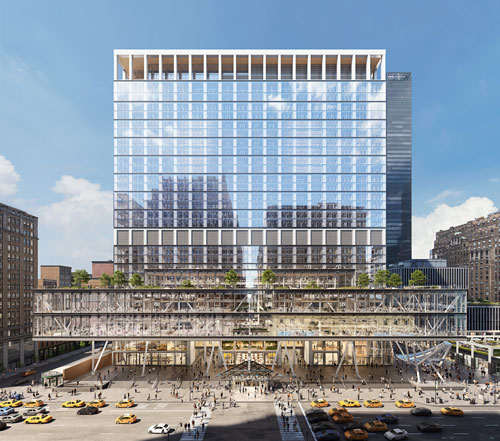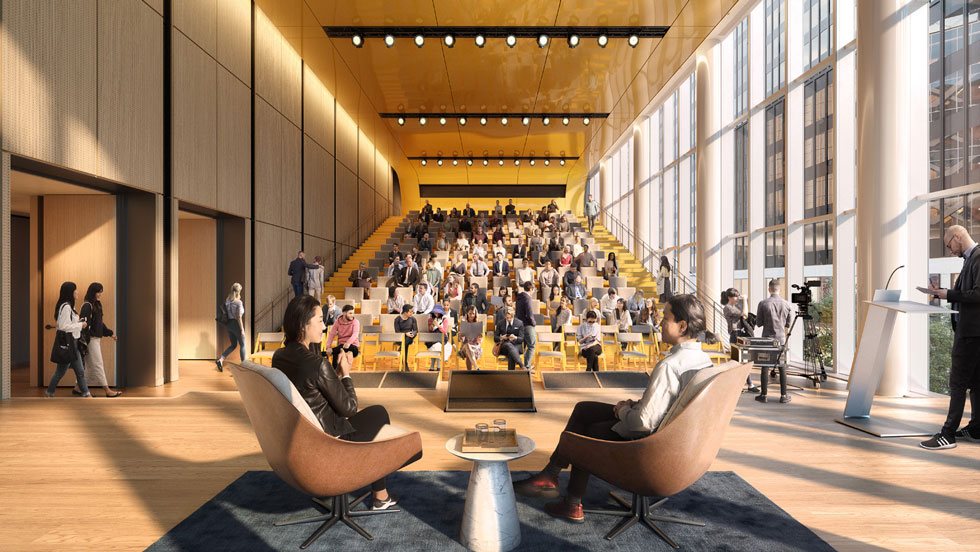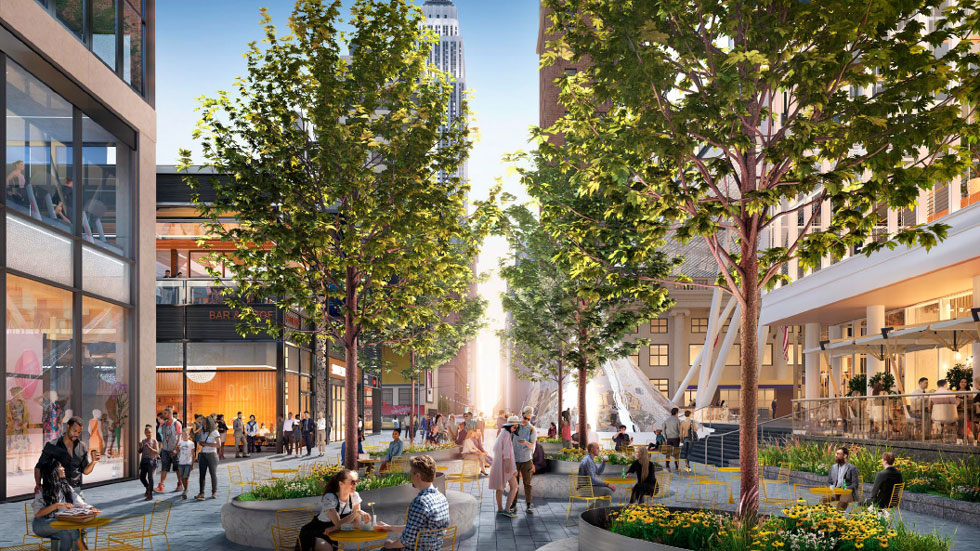Vornado is creating the neighborhood of the future in New York’s PENN District.
Just over a year after the grand opening of New York City’s Moynihan Train Hall, work to transform midtown Manhattan’s PENN District and reshape the city’s post-pandemic office culture, spearheaded by Vornado Realty Trust (NYSE: VNO), is continuing apace.
The $1.6 billion Moynihan Train Hall is the transportation cornerstone of New York’s PENN District, anchored by Vornado’s 10 million square feet of commercial property. The project has transformed the former mail-sorting area of the landmark James A. Farley Post Office Building into a modern transportation hub for rail travel.
A mixture of glass and steel, modern and historic, Moynihan is the new gateway for Amtrak and Long Island Rail Road passengers and contains an abundance of curated dining and retail options. Many New Yorkers and travelers are only now experiencing the award-winning design and thoughtful amenities as they return to offices and resume business travel.
“Because of the pandemic, most New Yorkers hadn’t been there yet,” says Dan Biederman, president of the 34th Street Partnership, a not-for-profit, private management company organized as a business improvement district focusing on the success of the neighborhood surrounding Penn Station. “As they discover it, it’s becoming a game changer for the west side of the 34th Street district.
According to Biederman, Moynihan is only just the beginning and a testament of what is to come. “Moynihan is a beautifully done station and the general public is finally getting the chance to appreciate it,” he says. In January, Amtrak opened a full-service bar in its new Metropolitan Lounge, featuring seasonal beer selections, wine, cocktails, and hot food as part of the ongoing expansion of amenities. Vornado also opened the Moynihan Food Hall in the concourse of the train station. Glen Weiss, Vornado’s EVP of office leasing and co-head of real estate, says “we are creating a new vibrancy in this business community—mixing new with old in authentic New York style.
Public-Private Partners
Vornado and the State of New York have invested heavily in the future of New York City. Dynamic new buildings will be integrated with updated iconic existing structures, some of which are more than 40 years old.
With a focus on an amenity-enriched office culture, the new PENN District aims to attract and retain top talent, leading a post-pandemic reemergence of businesses—large and small—in the Penn Station vicinity. Vornado’s team believes these critical investments in transportation and streetscapes will shape the future of what it means to go to work in Manhattan, arguably the center of global commerce.
“Many businesses who have been in this district for decades will be intertwined in the PENN District with new companies, and together can help one another flourish and invariably emerge from the pandemic stronger moving forward,” Weiss says.
Vornado’s history in the district dates back to 1997, Weiss explains. Thanks in part to its leadership’s forward-thinking vision and flexibility as a REIT, Vornado has invested in and accumulated key real estate in the vicinity of Penn Station over time, allowing it to now realize the full potential of the neighborhood. Weiss has witnessed this evolution first-hand, having worked in the district for decades.
Vornado’s predecessor in the neighborhood, the Mendik Company, which Vornado acquired in 1997, started accumulating properties in the PENN District in the 1980s. “We knew back then that this was the bull’s eye of New York, with transportation like no other commercial office district in the country,” Weiss says.
Over the next three decades the company continued to collect properties, gradually becoming the dominant owner in the neighborhood and enjoying consistently strong leasing thanks to the location.
According to Weiss, the area has historically attracted two tenant bases: commuters hailing from New York’s five boroughs, Long Island and New Jersey; and large corporations dependent on Amtrak train lines for movement of its employees along the Eastern Seaboard. As the area developed, Vornado actively sought to improve the district and surrounding neighborhood to attract a broader base of tenants from Manhattan’s other strategic office corridors.
More Liveable City
Vornado’s consistent aim on the advancement and acquisition of new properties perfectly positioned the REIT when it came time to make a bold investment and partner with the State of New York.
“Five years ago, we could see the time was right to invest significant capital to connect with the government in terms of a public-private partnership and get the PENN District to the next level,” Weiss says. With the Moynihan Train Hall and the new entrance into the Long Island Rail Road main concourse at Penn Station at the heart of this partnership, Vornado has committed $2.4 billion and federal, state, and local governments more than $3 billion.
“Vornado has played a major role in this very intricate public-private deal,” Biederman says. “It has survived the change of governors very well and the new governor is totally on board,” he says, referring to New York Governor Kathy Hochul, who recently took office and recommitted to the revitalization of Penn Station and the surrounding area.
“This plan puts New Yorkers first, delivering the rider-focused transit experience and great neighborhood they deserve,” Hochul said in a statement prior to taking office. “Investing in Penn Station means investing in New York’s future as we recover from COVID and build a more sustainable, livable city.”
Formerly known as Empire Station Complex Civic and Land Use Improvement Project, the updated Pennsylvania Station Area Civic and Land Use Improvement Project includes recommendations from private and public entities, such as the Community Advisory Committee Working Group (CACWG), which worked in consultation with Empire State Development, the Metropolitan Transportation Authority, Amtrak, and NJ Transit.
Five Years ago, we could see the time was right to invest significant capital to connect with the government in terms of a public-private partnership and get the PENN District to the next level.
Attracting Tenants
Biederman believes that Vornado’s thoughtful approach is paying off. Emergence of the tech industry and proximity to more recent attractions like the High Line and Hudson Yards have also helped make the PENN District’s and Vornado’s long-term investment even more appealing.
“Everything looks fresh and new here. It is obviously good for New York, it attracts new tenants that lead to more tax dollars for the city,” he says. As a business improvement district, the 34th Street Partnership supplements city services, tackling issues with litter, crime, graffiti, care of parks, tourist services, and neighborhood improvement.
Biederman says these additional services are particularly important at this time. “Right now there are concerns about many American cities going in the wrong direction and we are remedying that with a very sophisticated security force.”
Part of Vornado’s master plan for the PENN District includes updating iconic New York properties, adapting them to new industries, enhancing their sustainability, and strengthening the overall character of the neighborhood.
The Farley Building, formerly the city’s main post office branch, has retained its iconic Beaux-Arts architecture with Corinthian columns and classical steps, but has been revamped into a modern office space. The Farley Building will soon be the home to Facebook, who signed a lease for all 730,000 square feet of the office in August 2020— a major bet on Manhattan’s resurgence after COVID-19.
“Facebook first joined New York’s vibrant business and tech community in 2007. Since that time, we’ve continuously grown and expanded our presence throughout the city. The Farley Building, in the PENN District, will further anchor our New York footprint and create a dedicated hub for our tech and engineering teams. We look forward to being a part of this iconic New York City landmark’s future for years to come,” says Nick Raby, director of real estate and facilities, North America, at Meta, Facebook’s parent company.
Along with Facebook, the PENN District is attracting other top companies looking to bring their workforce back to the office and setting the tone for post-pandemic commerce. Apple Inc. signed a lease for a 330,000 square foot space at Vornado’s neighboring PENN 11
in 2020.
In another vote of confidence, Madison Square Garden Entertainment inked a 20-year lease in November 2021 for a 428,000 square feet headquarters at Vornado’s PENN 2, the 31-story building situated atop the current Penn Station.
“Vornado has been a great partner and we are pleased to have reached this agreement, which keeps our corporate headquarters at PENN 2—in the heart of the city next to our Madison Square Garden Arena,” James Dolan, executive chairman and CEO of MSG Entertainment, said at the time of the announcement.
In April 2021, work began on the redesign by MdeAS Architects and recladding of the mid-century modern structure, replacing the dark glass exterior with a modern glass curtain wall. PENN 2 will connect to another key district component—PENN 1—making the two buildings a 4.4 million square foot campus including a 280-person town hall for tenant presentations and events.
PENN 2’s redevelopment also creates 430 feet of new frontage along Seventh Avenue, as well as a second-level café adjacent to the office lobby and an 8,000-square-foot restaurant situated at a revamped 33rd Street pedestrian plaza, known as Plaza 33.
Amenity-Driven Work Culture
PENN 1, the building that occupies the area between 33rd and 34th Streets and 7th and 8th Avenues, is another renovation nearing completion mixing old and new New York.
The existing, 1970s Class A 55-story tower with more than 2.5 million square feet is undergoing a major redevelopment. As of July 2021, PENN 1 has a new North Lobby with high ceilings, a landscaped plaza, and a digitally-enhanced main “social” staircase connecting tenants and amenities.
Vornado introduced more than 200,000 square feet of tenant amenities, launching its new WorkLife amenity program—a hospitality-driven, work-first environment across the PENN campus. With a 35,000 square foot wellness and fitness center, multiple work lounge areas, full service-dining, bar, and grab-go food options, WorkLife creates an ecosystem that allows tenants to focus “on both work and self-care.”
Gone are the days of sitting in a cubicle for 10 hours, Weiss says. Coffee on hand, comfortable seating, lunch to-go, and support throughout the workday will allow employees to work in a “hospitality-centric office, closer to a hotel,” Weiss says. “It’s a terrific environment for the employee when they come into the office every day,” he adds.
Another Vornado first: access to all of the components of these office amenities via an accompanying app— Live.Work.Do. The phone application allows tenants from the PENN campus to access the on-site offerings, with everything from dining perks, entertainment, food and beverage ordering, safety alerts, and wellness tips with daily spotlights like #TrainerTipTuesdays and #WellnessWednesdays. The app will also expand and adapt as the PENN District grows and additional phases are completed.
According to Weiss, the ongoing COVID-19 pandemic and prevalence of work-from-home across industries have only accelerated the shift towards amenity-driven office culture.
“We believe when people come back to the office, they want to come into a very comfortable setting which provides everything in their office building that they otherwise were getting at home,” Weiss says. Vornado has also placed an emphasis on outdoor spaces throughout the district.
District for All
Vornado currently owns about 10 million square feet of property in the PENN District and has extensive, continually evolving plans for its next steps. “Everything is happening in parallel—improving the transportation hub, renovating buildings, new construction, upgrades to the streetscape,” Weiss says. “We are collaborating with the city, state, railroads, and local community to create the neighborhood of the future.”
Vornado will also continue the renovation and upgrading of all existing assets in the PENN District. Completion of PENN 1 is slated for spring of this year, and PENN 2 aims to wrap up in the second half of 2023.
For Vornado and its investors, the growth proposition remains limitless. Its architects Foster + Partners recently revealed updated designs for PENN 15, the tallest of its five proposed new office towers at 1,200 feet. The 2.7 million square foot “supertall” tower will feature terraces throughout the tower to maximize light and air and its unique design will allow for flexible office configurations. Other plans for the district include more than 10 acres of public plazas and sidewalks, as well as more than one million square feet of new retail.
“Personally, it is truly satisfying to still be here 30 years later to see all of this happening,” says Weiss, who likens each PENN District component to “chapters” of a story Vornado is building over time. “When the story is complete, tenants and stakeholders will see the quality of the future ecosystem, and the entire city will continue to reap the benefits,” he says.



